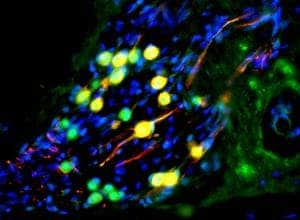In an exceptional feat of medical and technical ingenuity, scientists have been able to restore partial hearing to deaf gerbils by implanting modified human embryonic stem cells in their ears. The success rate is pleasing, and offers solid ground on which human trials with a similar treatment might commence.

There are many causes which might lead to hearing loss. The leading cause by far is related to damage to a special cell located inside the ear, equipped with hairs that sense vibrations and transmit them back to the brain through the neural connection to be decoded as sound. Another cause, however, experienced by 10% of the approximate 275 million people worldwide suffering from some form of hearing loss, is a condition called auditory neuropathy – the impairment of auditory neurons.
Targeting this specific deafness factor, the researchers at University of Sheffield UK implanted 18 gerbils, which had their auditory nerves rendered nonfunctional in the lab, with human stem cells. In the first phase, the embryonic undifferentiated stem cells were cultured by some specific chemicals to grow into auditory neurons. These were implanted into the gerbils ears and after a mere 10 weeks the first signs of success surfaced. During this time, the neurons grew fibers and reached the brainstem. To test if any hearing progress was made, the gerbils were subjects to sound wave while electrodes attached to their skulls measured brain waves for responses.
Thus, an estimated 46 percent increase in sensitivity was recorded, although the progress was rather inconsistent. A third A third responded exceptionally well, with some regaining 90 percent of their hearing, while another third showed almost no recovery at all. Still, for a human suffering from hear loss even the slightest progress could mean a shot at living a normal life. Can the procedure be transferred to humans in the first place?
Well, for one scientists have successfully managed to grow both auditory neurons and hair cells in stem cells cultures. The tricky part lies in the implant procedure itself. Unfortunately, hair cells require a very specific and precise orientation in the inner ear to function properly. Implanting hair cells precisely and safely is a great technical challenge, which many leading experts around the world view it as unreachable at this time.
“This is promising research that demonstrates further proof-of-concept that stem cells have the potential to treat a range of human diseases that currently have no effective cures. While any new treatment is likely to take years to reach the clinic, this study clearly demonstrates that investment in UK stem cell research and regenerative medicine is beginning to bear fruit,” said Dr. Paul Colville-Nash, Program Manager for stem cell, developmental biology and regenerative medicine at the Medical Research Council.
This latest research which shows promising results concerning stem cell treatment, coupled with an earlier independent research which used gene therapy to stimulate regeneration of hair cells in the cochlea, offers a much needed ray of hope to deaf patients around the world.
source






